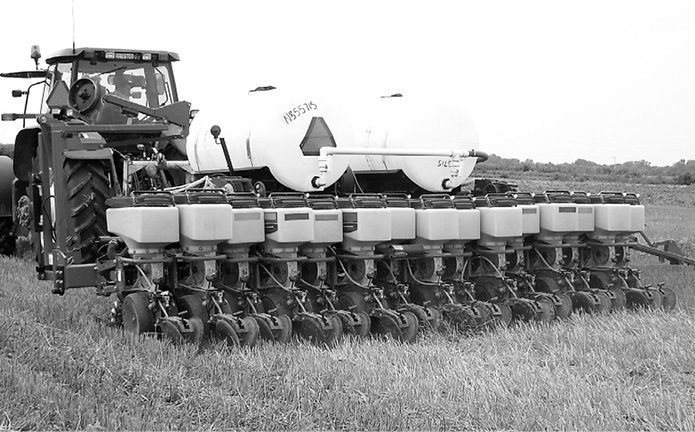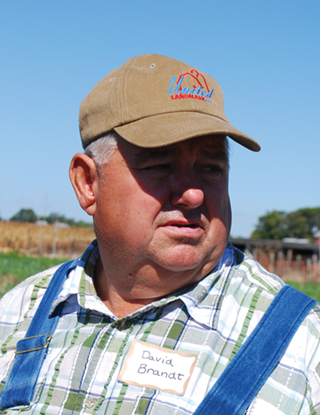Check The Specs...
NAME: David Brandt
LOCATION: Carroll, Ohio
YEARS NO-TILLING: 37
ACRES NO-TILLED: 900
CROPS NO-TILLED: CORN, SOYBEANS, WHEAT, ALFALFA, COVER CROPS (CEREAL RYE, AUSTRIAN WINTER PEAS, OILSEED RADISHES, SUNFLOWERS, SOYBEANS, HAIRY VETCH)
When I planted my first cover crop — cereal rye — in 1978 to control erosion on poorly drained, hilly clay soils, I had no idea what the full ramifications of that decision would be. Since then, cover crops have become the anchor of a diverse crop rotation in our continuous no-till system.
We credit several cover crops, most of them legumes, with amazing increases in organic matter, sharply reduced fertilizer costs, elimination of soil compaction, mellower soils and deeper water infiltration.
Our goal is to keep something of value growing on the soil surface for as many months as possible. The overall result has been better-than-average yields in years of bad weather and superior harvests in favorable growing seasons. Organic matter content has increased from 0.5% to 3%, even on our steeper 18% slopes.
EARLY LEARNING CURVE
Like many successful cropping systems, it took awhile to simultaneously make the physical — and mental — shift to continuous no-till and search around the country to find the best cover crops for our farm.
Chevron Chemical Co. provided an economical way to test cover crops in the early no-till years. Chevron marketed a program at that time to promote the company’s paraquat herbicide (Gramoxone).
Their plan called for planting a cereal rye cover after soybean harvest. In the spring, the rye absorbed enough excess water that we were able to plant corn on time, and then immediately kill the rye with paraquat.
We had varying success. Insect pressure, especially armyworms in corn, was heavier. But we never saw a failure with soybeans. So while we discontinued the rye cover in corn, we stuck with it in soybeans and are still using a similar program today.
PHASE 2
In the early ‘80s, we were still being paid for set-aside acres. While many growers seeded set-aside fields to a crop like sweet clover and left it to grow for several years, we tried something different. We were the first in the area to rotate set-aside, with the goal of improving soil tilth and drainage by improving a field each year.
With this plan, we chose a corn field for set-aside and planted that field into sweet clover. The clover plantings grew 5 to 6 feet tall, sinking roots 3.5 to 4 feet into the soil.
This was our first real understanding of the value of a deep-rooted legume. We were building a nitrogen reserve, as well as opening channels deep in the soil to improve water infiltration and extend root growth.
The next spring after the clover crop, we no-tilled corn directly into the sweet clover and sprayed it immediately after planting. Then we planted sweet clover into another set-aside field to repeat the cycle.
EXPLORING NEW COVER CROPS
Since those early rewarding experiences, our farm has become a test station for about every possible cover crop we could find. In addition to cereal rye and sweet clover, we’ve grown hairy vetch; big flower vetch; Austrian winter peas; crimson clover; dwarf rye; oilseed radishes; cowpeas; and even soybeans and sunflowers as cover crops.
The “winners’ that sifted out are hairy vetch, Austrian winter peas and oilseed radishes. We also continue to use cereal rye.
Hairy vetch does well on 6% to 18% slopes. It reaches a height of 36 to 42 inches by spring, virtually stops soil erosion and contributes 10,000 to 12,000 pounds of high-value organic matter per acre from a seeding rate of about 12 pounds per acre. Hairy vetch works best on well-drained soils that are not muddy or sticky.

In spite of some reports on hairy vetch being hard to kill, we haven’t had any problems. Our real learning curve was pulling a no-till planter in a 2.5- to 3-foot green mat for the first time! But it’s a big mistake to try and kill it before you plant. A heavy rain will turn the dead plants into a muddy mess that takes forever to dry out.
Austrian winter peas have a strong taproot that helps loosen the top 4 or 5 inches of soils. In years when the peas don’t winter kill, they’ll produce 19 to 20 inches of valuable root mass.
Because winter peas freeze completely off during winter, resembling a dead soybean field, we try to limit pea plantings to 6- and 7-degree slopes. (Hairy vetch goes on steep slopes; cereal rye on black, flat, mucky soils.)
The oilseed radish is a type of mustard originally grown for oil. But based on what it’s done in our no-till fields, oilseed radish should find a big market as a cover crop.
It grows fast in dry conditions with a deep taproot that can break up compacted soils 16 inches or deeper. That’s as deep as I could pull a subsoiler because of my tile system, so why not just let nature do the job?
Some reports also say oilseed radish contains allelochemicals, that when released during plant decomposition, are believed to help control soilborne pests and weeds.
A few years ago, I also liked to drill group 7 or 8 soybeans at about 125,000 plants per acre as a cover crop in wheat stubble. I already knew how to no-till soybeans, so I didn’t have a learning curve like with the other cover crops.
Group 7 and 8 soybeans seldom flower or produce pods in northern areas, so all the nitrogen they generate stays in the soil. Unfortunately, my seed source has pretty much dried up.
Sunflowers can be a good cover crop if you can sell them at local farmers’ markets. However, sunflowers are not a legume. They don’t manufacture additional nitrogen and will actually capture nitrogen that could have been used for your commercial crop.
NEW PLANTER HELPS
Over the years of no-tilling, we wore out John Deere 7000 and 7200 corn planters. They both did a good job with a minimum of attachments.
For soybeans and cover crop seeds, we used a Krause standard grain drill. The drill worked fine with soybeans, but we often overplanted cover crop seeds, which tend to be very small. A pound of oilseed radish, for example, contains 55,000 to 60,000 seeds. Because of the relatively high cost of seed, and the fact that we were getting uneven stands, we looked for a better option.

Last winter, we worked with AGCO engineers to design an eight-row White split-row planter equipped to plant 30-inch corn, as well as 15-inch soybeans and cover crops. This has been the best no-till machinery investment we’ve made in some time.
The White engineers paired us up with unique planter plates matched to seed size and planting speed. Now we get perfect seed depth and the same spacing between each seed, regardless of their small diameter.
We’ve also cut planting rates. When we started with cover crops, little was known about plant populations. We started out at 20 pounds per acre with radishes, and decided after a couple years of experimenting that 7 to 10 pounds with the no-till drill gave us the best size radish, but in uneven stands.
With the new planter, I can reduce radish seeding rates to only 1 pound per acre and still get good stands that are consistently 4 inches apart. Radishes end up 1.5 to 2 inches in diameter, growing 15 inches deep.
We’ve had similar cost-saving results with other cover crop varieties. When we first used hairy vetch, some experts recommended 40 to 60 pounds of seed per acre, which would have far exceeded its value.
Along the way, it took a little special effort by the engineers. At first, because the radish seeds are so small, static electricity that built up in the seed tubes prevented the seeds from flowing through.
Once they redesigned the brush with a ground wire, however, the problem was solved and seed flowed smoothly. It helps to have good field service when you’re trying something new.
Except for the innovative designs that allow near-perfect no-till corn, soybean and cover crop seed placement, we didn’t add anything else to the planter. It does a great job planting through dead or growing cover crops.
We don’t need row cleaners because, with our rotation of wheat, corn and soybeans, we’re not planting corn into old corn stalks. I’m convinced most no-tillers don’t need a lot of attachments if they will wait 2 or 3 more days to plant or drive a little slower and let the planter do what it’s capable of doing.
BIG DOLLAR RETURNS
We’ve seen remarkable nitrogen production when we seed hairy vetch or Austrian winter peas right after wheat harvest. The key is the amount of nodulation, which increases the earlier you seed these crops. Our comparisons show that both hairy vetch and Austrian winter peas generate between 100 and 200 pounds of nitrogen per acre per year.
How much is that worth? Well, if 28% nitrogen is going for $450 a ton, that’s 80 cents a pound. So if we’re saving 150 units of nitrogen, we’re looking at $130 to $140 in savings per acre for a cost of $23 in seed. (This example does not include any hourly costs for the planter or my time.)
And this doesn’t include the fuel savings we already get from no-tilling. On our farm, from planting to harvest with corn, soybeans or wheat, we use about 2.2 gallons of diesel fuel per acre.
A three-pass, conventional-tillage system would easily consume 8 to 10 gallons per acre. At $3 diesel, that’s a savings of about $20 per acre.
TAKE OUT GUESS WORK
To measure the consistency of a cover crop’s nitrogen-mining job, I track the nitrate soil tests and leaf tissue samples. I also “cover my bets” with test rows.
I apply 100% of normal nitrogen rates on a few given rows and then apply 50% of that same rate on a few other rows. If we get equal yields across the field, we know the cover crops have done their job. Yields on our soils tend to peak, regardless of fertility levels, at about 100-bushel wheat, 50-bushel soybeans and 160-bushel corn.
Knowing what’s happening beneath the surface is important. I never go to the field without a shovel. At least a dozen times a year, I study subsoil growth of cover crops, as well as the degree of nodulation on roots.
There’s nothing more rewarding than sticking the shovel in the ground 8 inches, pulling up a hairy vetch or pea plant and finding large white nodules the size of a man’s thumbnail throughout the root system. It means we can be confident of reaching our generated nitrogen target for the next crop.
If the nodules are only the size of a pencil lead, on the other hand, we know we probably aren’t going to bank as much nitrogen as we need. Fortunately, this doesn’t happen often and it can almost always be traced back to uneven inoculation.
DOUBLING UP
This year, to further improve our cover crop program, we leased an automated steering system and subscribed to RTK. As an experiment, I’m alternating oilseed radish and Austrian winter peas in every other planter box, thus planting two cover crops in 15-inch rows in a single pass across the field.

In the spring, I’ll plant corn 1 inch from the radish rows (something I couldn’t do without GPS), which will have decayed, creating a mellow cavity of soil to encourage faster root growth down to 16 or 18 inches.
As corn plants develop, they will also be drawing upon 180 units of nitrogen generated by the peas. We also think the deep-rooted radishes will bring up 5 to 20 pounds of phosphorus and 30 to 40 pounds of potash into the top 8 inches.
We’re excited to see the results in 2009. Very few farmers in my area have gone to this much precision technology, especially in situations like ours, where fields are uneven and small, ranging in size from 10 to 22 acres.
VEGETABLES NEXT
With rental land prices skyrocketing, my wife Kendra and I have sought an alternative source of income on 12 acres of vegetables, rather than expand crop acres. We sell through three nearby farmers’ markets located in an area of urban sprawl.
Our vegetable plot was the only place on our farm with bare soil and I was discouraged with the tons of soil we were losing in heavy spring rains. So, this past year, we started seeding hairy vetch and rye cover crops as the vegetables mature and are harvested. Next spring, we’re going to try a roller on the hairy vetch, similar to what well-known no-tiller Steve Groff has perfected in Pennsylvania.
SHARING WHAT WE’VE LEARNED
I’m proud to serve as president and now chairman of the Ohio No-Till Council, a group of 15 individuals who meet four or five times a year to discuss agricultural issues, particularly as they relate to no-till and other conservation farming methods. We also coordinate a field day during the summer months.
I’ve enjoyed being a member of the Ohio Innovative Farmers — a group dedicated to advancing sustainable farming — and serving on the county soil and water board.
This year, I’m “tutoring” a 62-year-old, 5,000-acre neighbor who has been watching our experiences with winter peas and radishes.
My first advice was that he would have to change his management style by seeding his cover crop and leaving the soil alone until he plants crops in the spring; then spraying the cover crop and devoting the time he would have spent tilling to walking fields, finding problems and learning how to correct them. And don’t forget to look under the ground.
We convinced him to plant 300 acres of Austrian winter peas and 200 acres of oilseed radishes this year. If it can work with a larger farmer, it will be a great showcase and incentive for our younger and smaller farmers.
He recently related that growing cover crops was about the most exciting thing he’s done in his whole farming career. He says it gives him the same good feeling he used to get after moldboard plowing.
I told him he’s still plowing — only with cover crops.








